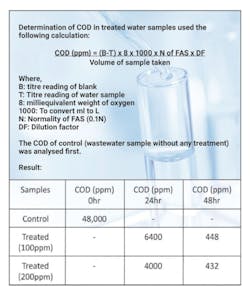About the author:
Steve Booton is founder and director for Custom Enzymes. Booton can be reached at [email protected].
The need to find simple and cost-effective solutions to solve complex issues concerning wastewater treatment is a considerable and ongoing challenge. The constant and continued use of chemicals, combined with old and outdated systems suggests that the water we drink may not be safe.
Biotechnology continues to gain popularity, particularly in the field of process improvement in various industries utilizing custom enzymatic formulations by removing chemical components or contamination. This allows wastewater treatment plants to reduce their environmental impact and achieve greater sustainable goals whilst also reducing expenditure.
The continued focus on environmental issues and impact from traditional (chemical) methods has led to an increased shift towards a greener alternative. Integrating biotechnology can improve sustainability across many applications of production.
Custom enzymatic formulations can be developed to serve various industries relying on chemicals to produce the end product or treat a problem. By integrating these formulations into the wastewater process, positive outcomes such as greater efficiency, higher quality product and a clean, safe environment can be achieved.
An enzyme is a biological catalyst. Like all catalysts, it increases the rate of the reactions it takes part in without being used up.
Each enzyme has an active site, which is specific for a certain substrate. The idea of the substrate fitting “just right” to the active site of the right enzyme is called the “Lock and Key.” The enzymes will not interact with anything other than what it is designed to treat.
Innovation plays a significant role towards operational efficiency and no doubt is always a priority in treatment facilities. Great advances have been made in the development of efficient technologies with the introduction of specific custom designed enzymatic treatments that can address some of the challenges still faced, such as energy reduction, managing sludge volumes, BOD and COD levels and odor removal.
Advantages of Enzymatic Treatment
The use of custom enzymatic formulations is leading an increased interest for biocatalysts that show improved or new properties in wastewater treatment.
By specifically acting on certain pollutants, enzymes are able to remove them by precipitation or transforming them to different products. Biological (enzymatic) procedures have an additional advantage over conventional chemical/physical strategies as they are viewed as more clean and green. The different physicochemical treatments like chemical precipitation, coagulation, flocculation, floatation, and membrane filtration offer benefits like the simplicity of activity and control, flexibility to change in temperature and they are quick. Yet their advantages carry various disadvantages, such as their operational expenses due to the utilized chemical compounds, high energy utilization and expenses for sludge removal.
A custom enzyme formulation is explicit and is a proficient catalyst. It can corrupt a target pollutant without influencing different parts in the effluent. Moreover, a formulation can work under mild reaction conditions, particularly temperature and pH. In this regard, custom enzymes are a concerted alternative to common catalysts used.
Enzymes & Biodegradation
From an environmental viewpoint, enzymes are increasingly acceptable due to their biodegradability. On account of reactions wherein the objective pollutant is oxidized, the enzyme gets at least one electron from the substrate and gives these electrons to an electron acceptor. Towards the end of the reaction, the enzyme is recovered and is accessible for the following reactant cycle. The biological origin of enzymes diminishes the enzymes’ unfavorable effect on the environment, making enzymatic wastewater treatment an ecologically sustainable technique.
Putting Concept it to Practice
Looking at the all the issues facing treatment plants, the continuous testing and presence of chemical oxygen demand (COD) was highlighted as one of the major factors. COD is a critical metric used for testing the effectiveness of wastewater treatment. The test is used by the industry as it can be carried out almost continuously unlike the biological oxygen demand (BOD) test, which can take several days. In the example below, the COD result appeared high indicating that there were issues with the wastewater treatment.
Test Scenario
Objective: Aerobic degradation of wastewater obtained from paint & pharmaceutical industries using custom formulation. Test used one of two doses: 100 ppm or 200 ppm.
Procedure: Treatment of two wastewater samples with Pure Aero
at two different dosages with aeration for 24 hours to determine the COD of each sample.
Test Conclusion: From the results, it can be observed that significant degradation of wastewater is obtained using the custom enzyme formulation and continuous use in the system is recommended.
The custom formulation acts as a bioremediator due to the combined action of enzymes and microorganisms in disintegrating organic matter’ solvents and other chemical constituents into less toxic or non-toxic compounds, hence reducing the COD of wastewater.
The use of custom enzyme formulations for the treatment of wastewater does not stop at reducing oxygen demand. From an efficiency and process perspective the benefits
are competitive compared to conventional methods.
The formulation begins to degrade organic waste immediately upon application and as any formulation is tailored specifically, it is designed to work in sync with bacteria. Enzymes present in both the aerobic and anaerobic products break up long, complex waste molecules (Hydrolytic reaction) into smaller pieces, which can then be digested directly by the bacteria.
From this initial application reaction, the capacity of the system will be effectively increased. This happens because more waste can be processed more efficiently and in less time as the sludge volume reduces due to more solids being digested. Therefore, the remaining sludge becomes easier to pump, process and dewater.
Maintenance & the Bottom Line
The buildup of bacteria and moisture producing hydrogen sulfide is the root cause leading to corrosion from sulfuric acid. With the introduction of specifically designed and tailored custom enzymes into wastewater processes, it is possible to achieve a significant reduction in sulphate (SO4) build up. Thereby reducing the amount of sulphides (SO2) that can form at every stage within the process.
Customized enzymes solutions can protect infrastructure and save money by reducing the necessity to replace machinery and pipelines as often, by reducing the presence of sulfuric acid. There is also the positive impact on neighboring communities near any treatment facility including sulfuric build up and reducing the presence of odor.
In addition to all the operational advantages, effluent water standards will be met more consistently, helping maintain a cleaner environment and safer drinking water for the population.
Conclusion
Biotechnology by means of enzymatic reaction signifies a novel approach towards replacing chemicals or treating industrial problems that lead to a risk on the environment and human health.
Outcomes rely on government, industry participation and an acceptance to move away from traditional methods and controls.


